24 Hours of Le Mans
| Year | Drivers | Car | Class | Laps | Pos. | Class pos. | |
|---|---|---|---|---|---|---|---|
| 1959 | | Lotus Elite Mk.14-Climax | GT 1.5 | 257 | 10th | 2nd | |
| 1960 | | Aston Martin DBR1/300 | S 3.0 | 306 | 3rd | 3rd | |
| 1961 | | Aston Martin DBR1/300 | S 3.0 | 132 | DNF | DNF | |
Source: [8] | |||||||
Border Reivers was a motor racing team from Chirnside, Berwickshire in the Scottish Borders. The team was named after the raiders along the Anglo-Scottish border. Its most successful achievement was third place at the 1960 24 Hours of Le Mans. It is most notable for its involvement in the early racing career of Jim Clark, who was one of the drivers in the 1960 Le Mans entry.
Jock McBain owned an engineering business and a car dealership in Chirnside, Berwickshire. He was a keen amateur racing driver and was instrumental in developing local airfields Winfield and Charterhall as motor-racing circuits. He encouraged friends to take up motor racing, primarily in Cooper 500s, and between them they formed Border Reivers. However, unlike rivals Ecurie Ecosse funding was in short supply and McBain closed down the team in 1956. [1]
In late 1957, McBain was comprehensively beaten at Charterhall by Jim Clark and suggested to Clark's mentor Ian Scott-Watson that he manage a revived Border Reivers with Clark as driver. A Jaguar D-Type was purchased and Clark immediately began winning sports-car races the length and breadth of the UK. A trip to Brands Hatch to evaluate a possible purchase of a Formula 2 Lotus led instead to the purchase of a Lotus Elite. [2] This car was entered in the 1959 24 Hours of Le Mans to be driven by Clark and Sir John Whitmore. They finished tenth overall and second in class. [3] An ex-works Aston Martin DBR1 was then purchased and this car finished third at the following year's Le Mans, driven by Clark and Roy Salvadori. [4] In 1961, with Clark now partnered by Ron Flockhart, the Aston failed to finish. [5]
Border Reivers never entered a World Championship F1 race but did compete in several non-championship events, their best result being third place in the 1954 and 1955 Curtis Trophy with Jimmy Somervail's Cooper T20-Bristol. [6]
In 1961 Jim Clark moved on to greater things and with the death of Jock McBain in that same year the team was wound up, but not before Flockhart had some success in Australia and New Zealand running a Cooper T51-Climax under the Reivers' banner.
The Border Reivers name has been revived on several occasions since, most recently running cars in Formula Ford 1600 and sports-car racing. [7]
| Year | Drivers | Car | Class | Laps | Pos. | Class pos. | |
|---|---|---|---|---|---|---|---|
| 1959 | | Lotus Elite Mk.14-Climax | GT 1.5 | 257 | 10th | 2nd | |
| 1960 | | Aston Martin DBR1/300 | S 3.0 | 306 | 3rd | 3rd | |
| 1961 | | Aston Martin DBR1/300 | S 3.0 | 132 | DNF | DNF | |
Source: [8] | |||||||

James Clark OBE was a British racing driver from Scotland who won two Formula One World Championships in 1963 and 1965. A versatile driver, he competed in sports cars, touring cars, and in the Indianapolis 500, which he won in 1965. He was particularly associated with Team Lotus, driving for the team his entire Formula One career between 1960 and 1968.

Sir John Young Stewart OBE is a British former Formula One racing driver from Scotland. Nicknamed the "Flying Scot", he competed in Formula One between 1965 and 1973, winning three World Drivers' Championships and twice finishing as runner-up over those nine seasons. He was the only British driver to win three championships until Lewis Hamilton in 2015.
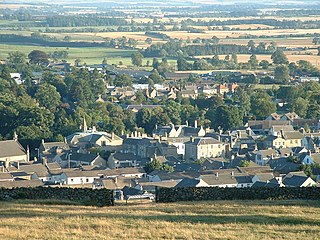
Duns is a town in the Scottish Borders, Scotland. It was the county town of the historic county of Berwickshire.
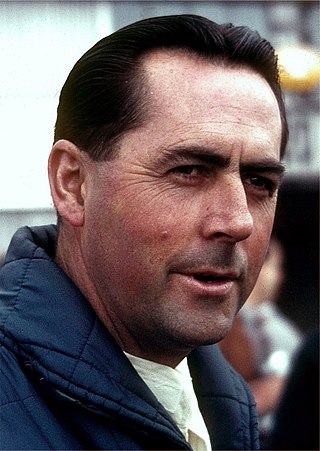
The 1960 Formula One season was the 14th season of FIA Formula One motor racing. It featured the 11th World Championship of Drivers, the third International Cup for F1 Manufacturers and five non-championship Formula One races. The World Championship was contested over ten races between 7 February and 20 November 1960.
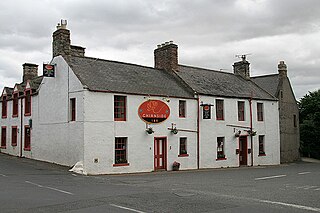
Chirnside is a hillside village in Berwickshire, Scotland, 9 miles (14 km) west of Berwick-upon-Tweed and 7 miles (11 km) east of Duns.

Roy Francesco Salvadori was a British racing driver and team manager. He was born in Dovercourt, Essex, to parents of Italian descent. He graduated to Formula One by 1952 and competed regularly until 1962 for a succession of teams including Cooper, Vanwall, BRM, Aston Martin and Connaught. Also a competitor in other formulae, he won the 1959 24 Hours of Le Mans in an Aston Martin with co-driver Carroll Shelby.

Ian Macpherson McCallum Stewart was a British racing driver from Scotland.

Ivor Léon John Bueb was a British professional sports car racing and Formula One driver from England.

Richard James David "Dickie" Attwood is a British motor racing driver from England. During his career he raced for the BRM, Lotus and Cooper Formula One teams. He competed in 17 World Championship Grands Prix, achieved one podium and scored a total of 11 championship points. He was also a successful sports car racing driver and won the 1970 24 Hours of Le Mans race, driving a Porsche 917, the first of Porsche's record 19 victories at the famous race.

William Ronald Flockhart was a British racing driver. He participated in 14 World Championship Formula One Grands Prix, achieving one podium finish and won the 24 Hours of Le Mans sportscar race twice.

The Lotus 49 was a Formula One racing car designed by Colin Chapman and Maurice Philippe for the 1967 F1 season. It was designed around the Cosworth DFV engine that would power most of the Formula One grid through the 1970s. It was one of the first F1 cars to use a stressed member engine combined with a monocoque to reduce weight, with other teams adopting the concept after its success. An iteration of it, the 49B, also pioneered the use of aerofoils to generate downforce.

The 1961 24 Hours of Le Mans was a motor race for Sports cars and Grand Touring cars staged at the Circuit de la Sarthe, Le Mans, France on 10 and 11 June 1961. It was the 29th Grand Prix of Endurance and the fourth race of the 1961 World Sportscar Championship. Ferrari and Maserati were the main contenders, with Aston Martin an outside chance.

The 1960 24 Hours of Le Mans was the 28th 24 Hours of Le Mans Grand Prix of Endurance, and took place on 25 and 26 June 1960, on Circuit de la Sarthe. It was the fifth and final round of the F.I.A. World Sports Car Championship as well as being the fifth round of the inaugural FIA GT Cup. It was held just a week after the tragic Belgian F1 GP in which two drivers were killed and Stirling Moss and another driver were seriously injured. The prospect of a duel between the 3-litre (180 cu in) Ferrari versus the 2-litre (120 cu in) Porsche championship-leaders was enough to draw large crowds to the 24 Hours race and some 200,000 spectators had gathered for Europe's classic sports car race, around the 13.5 km (8.4 mi) course.

The 1959 24 Hours of Le Mans was the 27th 24 Hours of Le Mans, Grand Prix of Endurance, and took place on 20 and 21 June 1959, on Circuit de la Sarthe. It was also the fourth round of the F.I.A. World Sports Car Championship. The prospect of an exciting duel between Ferrari, Aston Martin and giantkillers Porsche was enough to draw large crowds and some 150,000 spectators gathered for France's classic sports car race, around the 8.38-mile course.
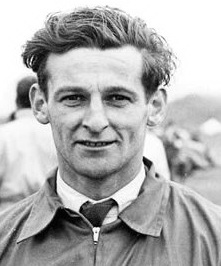
Ninian Sanderson was a Scottish car dealer, sports car racing driver, and winner of the 1956 24 Hours of Le Mans.
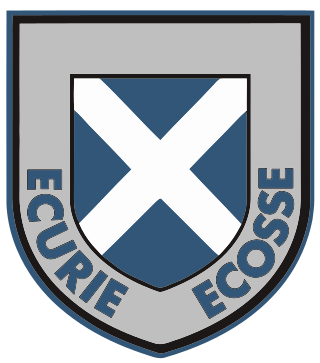
Écurie Écosse(in French) was a motor racing team from Edinburgh, Scotland. The team was founded in November 1951 by Edinburgh businessman and racing driver David Murray and mechanic Wilkie Wilkinson. Its most notable achievement was winning the 1956 and the 1957 24 Hours of Le Mans. The team also raced in three Formula One races. Ecurie Ecosse's cars were always distinctive in their flag blue metallic paint.
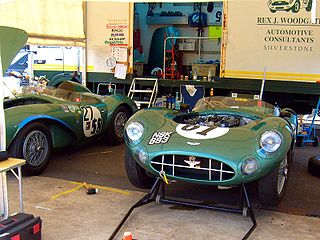
The Aston Martin DBR1 is a sports racing car built by Aston Martin starting in 1956, intended for the World Sportscar Championship as well as non-championship sportscar races at the time. It is most famous as the victor of the 1959 24 Hours of Le Mans, Aston Martin's only outright victory at the endurance classic. It is one of only three cars in the 1950s to win both the World Sports Car Championship and Le Mans 24 Hours in the same year. In addition the six World Sports Car Championship victories was a record for any car in the 1950s and remained a record in the championship until surpassed by the Ferrari 250TR. The three consecutive triumphs in 1959 at the Nürburgring, Le Mans and the Tourist Trophy equalled the record set by the Ferrari 250TR with its three consecutive victories at the start of the 1958 season.

Royal Air Force Charterhall or more simply RAF Charterhall is a former Royal Air Force station located in the Scottish Borders and the historic county of Berwickshire between the village of Greenlaw and Duns. It was originally a First World War landing ground named Eccles Toft. The airfield was reconstructed in 1942 and was used mainly by No. 54 Operational Training Unit during Second World War. The RAF left in 1947 and the airfield was officially closed.

John Coombs was a British racing driver and racing team owner. After a driving career in various formulae, including a win in a minor Formula One race, he became a team owner in sports car racing and Formula Two. During the 1960s and 1970s, working closely with Tyrrell Racing, he ran cars for several top drivers of the time, including Jackie Stewart, Graham Hill and Jack Brabham.
Michael Geoffrey Beckwith is a British former racing driver from England who competed in various classes in the 1960s and 1970s including non-championship Formula One and the Le Mans 24-hour race.